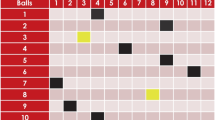Abstract
Consider a supply of balls randomly distributed into n distinguishable urns and assume that the number  of balls distributed into any specific urn is a random variable with probability function
of balls distributed into any specific urn is a random variable with probability function  . The joint probability function and binomial moments of the number K
i
of urns occupied by i balls each and the number K
j
of urns occupied by j balls each, i≠j, given that a total of S
n
=m balls are distributed into the n urns, are derived in terms of convolutions of q
x
, x=0,1, . . . and their finite differences. Also, some illustrating examples are discussed.
. The joint probability function and binomial moments of the number K
i
of urns occupied by i balls each and the number K
j
of urns occupied by j balls each, i≠j, given that a total of S
n
=m balls are distributed into the n urns, are derived in terms of convolutions of q
x
, x=0,1, . . . and their finite differences. Also, some illustrating examples are discussed.
Similar content being viewed by others
Author information
Authors and Affiliations
Corresponding author
Rights and permissions
About this article
Cite this article
Charalambides, C. Derivation of a joint occupancy distribution via a bivariate inclusion and exclusion formula. Metrika 62, 149–160 (2005). https://doi.org/10.1007/s00184-005-0413-0
Issue Date:
DOI: https://doi.org/10.1007/s00184-005-0413-0



